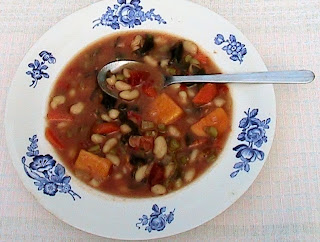Is there a difference between the cranberries and lingonberries? Yes, they are one ocean apart; they grow in different environments: the size is different; and the taste is different. Cranberries are grown in the northern part of the United States and Canada, too, I am sure. Lingonberries are grown in the northern part of Europe, e.g. in Sweden.
The cranberries in this country are grown in bogs whereas the lingonberries are grown in a rocky, dry, and sunny climate. The cranberries are much larger than the lingonberries but they are both tart; however, I do believe that the lingonberries may be a tad sweeter: they have been kissed by the sun.
During my years in Sweden, my friends and I filled a thermos with coffee, packed sandwiches and cookies in a rucksack, grabbed the berry picker, and headed for the sunny and rocky areas to pick lingonberries.
With the lingonberry picker, we scooped up the berries from the small evergreen shrubs. The berries fell on through to the back of the picker while the debris was caught in the front and was easily discarded.

Most often I like to serve lingonberry jam or sauce with Swedish meatballs and I also like to have them with fried beef liver. Actually, lingonberries go with just about any meat dish and potatoes.
The lingonberries are served at IKEA restaurants with their meatballs, and, of course, you may be able to purchase the berries at their food store. You may also be able to purchase lingonberries at gourmet food stores. Otherwise, cranberries will do fine.
In time for Thanksgiving, I made cranberry sauce (jam) from fresh cranberries purchased at the grocery store. I followed the recipe on the package with some changes: Bring 1 cup water, 1 cup cup sugar, and the cranberries to a boil. I added another 1/2 cup of sugar and 3 Satsuma oranges (they are small) that I peeled and cut up. I simmered this concoction for about 20 minutes. It gave me almost 2 cups of sauce or jam.
Whatever you have with your turkey and all its trimmings, enjoy with family and friends.
Thank you for visiting my blog.
 I am blessed and give thanks that my husband and I are able to celebrate another holiday together. I am blessed and give thanks that we are able to work and enjoy our Back Forty Garden and Park.
I am blessed and give thanks that my husband and I are able to celebrate another holiday together. I am blessed and give thanks that we are able to work and enjoy our Back Forty Garden and Park.

















